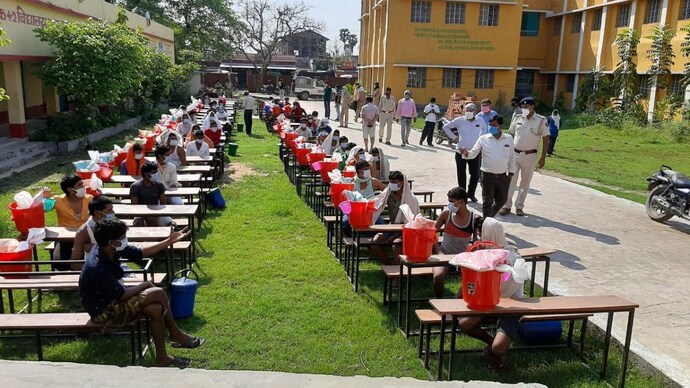Hope floats in Bihar’s quarantine camps | India Today Insight
Some 225,000 people are lodged in the state’s isolation facilities

 On May 13, as a special train from Surat reached Darbhanga in Bihar, friends Ramanji Mandal, 39, and Sanjay Mandal, 32, heaved a sigh of relief. The going had been good for the two migrants in Gujarat till the corona crisis pushed them to the
On May 13, as a special train from Surat reached Darbhanga in Bihar, friends Ramanji Mandal, 39, and Sanjay Mandal, 32, heaved a sigh of relief. The going had been good for the two migrants in Gujarat till the corona crisis pushed them to the
brink. From earning Rs 20,000 a month in one of Surat’s diamond cutting and polishing units, they found themselves digging into their savings for survival as work stopped on March 22.
Housed in a state disaster management authority-run quarantine centre at MLSM College in Darbhanga, the duo, from Ghorghatta village, sips their evening tea and contemplates their options. Even if things look bleak for now, it is preferable to stay back home for the next few months, they feel. “Being in Bihar itself is reassuring. Our families are less worried about us,” says Ramanji Mandal.
The MLSM College quarantine facility hosts around 200 people. The Mandals, like thousands of other migrant workers returning to Bihar, have to complete a 21-day isolation period. For migrants, the state government had extended the standard 14-day quarantine by seven days. Officials termed it as an additional precautionary measure. The government, however, is now contemplating making the last seven days home quarantine. A decision is awaited.
Arrangements at these quarantine facilities are elaborate. “All inmates are provided breakfast, lunch and dinner, and milk twice a day,” says Kailas Mandal, the officer on duty at the Darbhanga quarantine centre. “Each person has been provided separate steel utensils, which they can carry along while leaving the camp. Medical facilities have also been arranged for.” According to the state disaster management authority directive sent to all 38 district magistrates, men, women and children at the shelters are to be provided clothes, towels, buckets, detergent powder, sanitisers and mosquito nets. The provisions also include sanitary napkins for women and toiletries such as soap, toothbrush, toothpaste, shampoo and hair oil.
Television sets, with cable TV connection, have been installed at most quarantine centres. Arrangements have been made at several centres for yoga, outdoor sports such as cricket and badminton and indoor games like Ludo and carom.
Bihar was taken by surprise when soon after the nationwide lockdown from March 25; an estimated 175,000 migrant workers flooded the state in buses arranged by the Uttar Pradesh government. Now, as Lockdown 3 nears end, the state appears better prepared to handle the continuing inflow of migrants. Officials say approximately 400,000 migrants have made their way back to the state so far. Of these, over 120,000 stranded workers came by 104 special trains; another 160 trains are scheduled to arrive in the next one week.
Bihar presently runs over 4,000 block-level quarantine centres for migrants where more than 225,000 people are lodged. In addition, around 75,000 people have been put up at 162 disaster relief centres. “The numbers will increase in the next few weeks. With the chief minister ordering us to bring every stranded Bihar migrant back home, the number may touch one million in the days and weeks to come,” state chief secretary Deepak Kumar told INDIA TODAY. Officials estimate the total cost of housing a million migrants in the quarantine camps at over Rs 500 crore.
Though running block-level quarantine centres is a logistical nightmare, Chief Minister Nitish Kumar’s directive is clear: every migrant returning to Bihar should be quarantined. “Nitish Kumar’s thrust is as much humanitarian as a well-thought-out strategy. He wants to help all migrant workers returning home, but is equally determined not to allow the spread of COVID-19 into rural Bihar, where 88 per cent of the population resides,” says a top state bureaucrat.
The block quarantine camps have also caught the Centre’s attention. During a recent video conference with the chief secretaries of all states, cabinet secretary Rajiv Gauba lauded Bihar’s efforts and described them as worth emulation by the other states.
Not that there haven’t been adverse reports from some quarantine facilities. “In some places, we received reports about cooks not willing to serve the migrants over fear of infection. We replaced them. There have also been instances of emotions getting the better of the inmates and arguments breaking out. Such things are expected,” says a bureaucrat involved in the management of quarantine centres. “However, the state’s larger success lies in the fact that we have kept the incoming migrants isolated from the population in the rural areas.”
In the adjoining room at the Darbhanga quarantine centre, Sanjay Sahni, 30, and his wife Vibha Devi, 26, have finished their lunch of rice, dal and soybean curry. The two were walking back from Nepal when state officials spotted and shifted them to the centre on April 25. The couple used to sell ayurveda medicines from Nepal in the state’s Bhagalpur area and is worried about their livelihood. Vibha Devi hopes to figure out their life in due course of time. “It’s fine for now, we have everything. We feel safe here,” she says.
As per Nitish Kumar’s directive, the state government is making arrangements for the supply of soap bars and face masks to every family in the rural areas. Given the state’s rural population, it’s a huge target. But officials are determined to take this hand-hygiene campaign to every home.
Subscribe to the daily newsletter for sharp insights delivered straight to your inbox https://www.indiatoday.in/newsletter
